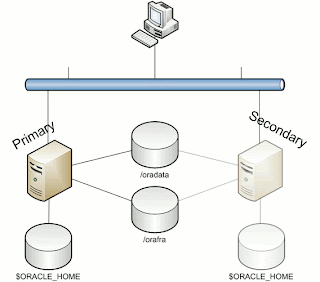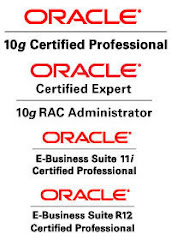However, it is always interesting to see what the next upcoming release will contain. I will stick to the Applications Technology, because that is my part of the pond:
Technology Highlights
- The most eye-catching new feature is support for 11gR2 database. Unfortunately (in a way) 11gR2 will not be shipped with 12.1.2. It'll still come with 11.1.0.7.
- On the middle-tier, support is introduced for AS 10gR3 (10.1.3.5) which will be shipped with the release, JDeveloper 10.1.3 and it uses the Sun Java Plug-in version 6.
- The Application Server for Forms and Reports will be 10.1.2.3. The maintenance pack will either include or require customers to upgrade to this version.
- Of all externally installed Oracle technology (WebCenter, Discoverer, Portal, Internet Directory, SSO, BPEL PM, OBIEE, OEM, etc) the most recent version will be certified with 12.1.2.
Internationalization Highlights
- Added support for Lithuanian, Indonesian and Ukrainian languages.
- Space and single quote number group separators
- First day of the week support (choose whichever day is the first day of the week)
- The Gantt chart and inline date picker features support Thai and Hijrah calendars
Oracle Applications Framework Highlights
- Redesigned Home Page
new folder-like structure, better spacing, favorites are now in a pull-down menu. In general the home page is more compact and allows for easy extension and custom content. - New Navigator Menu and favorites Pull-Down menue in the Global Header area
The Navigator Menu now appears in every OAF page (Pull-down menu). Favorites menu is also a pull down menu from the Global Header area and allows for marking the current page as favorite. - Look-ahead capability in lists of values
When entering a limited number of characters in a field, an inline window will let you select from a list of values based on the characters you typed. This way, you can limit the number of values in the inline window and ease your search for the correct value. - ability to add, view, edit and delete attachments inline
Inline attachments now have a hover-over interaction allowing users to view, add, edit and delete attachments to an entity. This capability eliminates the need to go to the Add and View attachments pages to maintain attachments. - pop-up component
This allows applications to display a pop-up window on top of an OAF page. - Portlet Generator
For static conversion of a standalone OAF region into a portlet. These can be embedded in any portal application or WebCenter. - A new component: rich container that can hold OBIEE content.
Through personalization, users can configure this component to hold a certain OBIEE report that accepts specific parameters.
Oracle Application Object Library Highlights
- Oracle Access Manager integration support
OAM can be used in stead of Oracle Single Sign On for thos applications or products that support it, but it can also be used together with OSSO to provide centralized authentication. - AOL Java APIs
Support for Oracle E-Business Suite Release 12.1.2 is provided - Scheduling Charts UI Enhancements
Dragging task numbers into the scheduling chart to create new tasks and shifts on the fly. Simplified ability for creating, assigning, searching and displaying new task assignments from a single source.
Diagnostics Framework
- Added support for XML file type diagnostics.
Integrated SOA Gateway
- SAML Token Support
E-Business Suite environments can trust external systems. These external systems can use a public key to authenticate a SOAP request using SAML. - Enhanced SOA Diagnostics
To check the health of the EBS Integrated SOA Gateway. - New interface type: Java APIs for Forms
these are XML document based interfaces, wrapped in Java classes to execute logic in Oracle Forms. Integrated in the Oracle Integration Repository (iRep) - Integrated SOA Gateway Customization
Support for custom integration interfaces, that can be deployed as custom Web Services. Customization feature is provided through the Integration Repository Parser.
Web ADI Highlights
- Introducing the Web Applications Desktop Integrator Extension Framework
wizard-based UI to create and manage desktop integrator solutions, providing a user-friendly approach to create custom integrators, without having to know the complexity of the EBS Schema.
Conclusion
My personal curiosity is focused on 11gR2 (I would be really interested in seeing the E-Business Suite running on 11gR2 Grid Infrastructure!). For sure there is enough to lookout for. Again, I am eagerly awaiting this new release.


